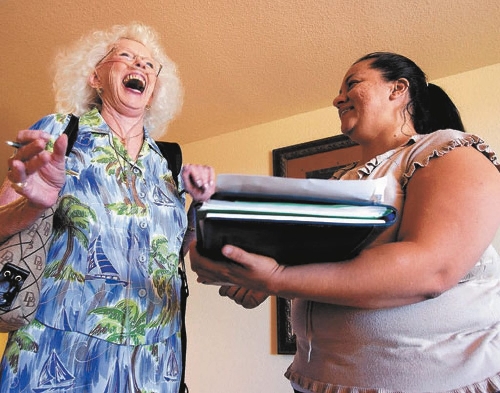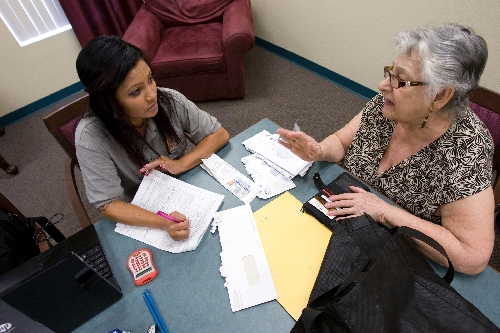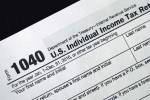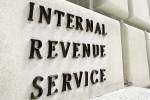Getting food stamps a SNAP
Vivian Haas has trouble making ends meet on her modest monthly Social Security and pension income.
But the 79-year-old retired cocktail waitress never imagined she might qualify for food stamps.
"It's a little tight each month -- half my income goes to rent," Haas said. "But I didn't think I was eligible."
Plenty of her neighbors, who like her are residents of the Rochelle Pines Senior Apartments near Flamingo and Pecos roads, also said they didn't know they qualified for help through the federal Supplemental Nutrition Assistance Program, known informally as SNAP and more commonly as food stamps.
"I had no idea," Maricela Galindo, 66, said as she waited for help applying for the program at the apartment complex one afternoon last week. "It would be nice, when you go shopping, to not have to choose between one thing and another because you can't afford both."
Nevada historically has had among the lowest participation rates in the federal food stamp program. But that appears to be changing as the recession drags on and Nevada's unemployment rate remains the highest in the nation. The number of Nevadans who receive food stamps has nearly doubled in the past two years.
And food stamp outreach programs, such as that started this year by Three Square Food Bank, aim to sign up even more people.
"We've found that people are overwhelmed by the application process or may not even realize that they qualify for benefits," said Julie Murray, president and CEO of the food bank. "It is critical that we use every available resource to put food on the tables of families in need."
Three Square launched the program after completing a report on hunger earlier this year that found that about 100,000 people in Clark County experience "very low food security," or have had to reduce their food intake or skip meals, based on data from the U.S. Department of Agriculture, which administers the federal food stamp program.
Children and seniors are the most likely to go hungry, according to the report.
Three Square's "SNAP team" visits dozens of community sites to help people apply for food stamps. As of the end of July, the team has submitted 1,249 applications. The food bank also recently expanded the program to Nye, Lincoln and Esmeralda counties.
Successful applicants join the rapidly expanding list of food stamp recipients in Nevada. In 2008, 147,361 people received food stamps in the state. So far this year, 283,683 people are signed up. More than 5,500 new Nevada participants on average signed up each month between July 2009 and July 2010.
Nevadans received roughly $158 million in federal food stamp benefits in 2008. This year, they are on track to receive more than $381 million .
Murray says that, based on USDA calculations, every $1 in food stamp benefits generates about $1.73 in economic activity, as grocers and farmers pay their employers and suppliers, who then shop and pay their own bills.
According to the USDA, only 52 percent of SNAP-eligible Nevadans participated in the program in 2007, the latest year for which the department compiled figures. Nevada was ranked 48th among U.S. states for its participation rate in the program.
Elderly people and those who live in households with some income are the least likely to sign up for food stamps, said Miki Allard, staff specialist with the Nevada's Welfare and Supportive Services.
Nevada historically has had a more transient population that included fewer skilled workers accustomed to living on lower incomes, she said. And Nevada includes a lot of rural areas where it's more difficult to apply for benefits.
"It's easier to apply in an urban area than when you're living in Gabbs," she said, referring to a small town about 100 miles east of Carson City.
But for many, the only obstacle is being unaware of their eligibility.
Haas has a monthly income of about $1,200, well below the qualifying $1,806 maximum for a single-person household. She may wind up receiving only a small amount in food stamp benefits -- the minimum awarded is $16 a month -- but says even a few dollars would be a big help.
After paying for rent, utility bills and out-of-pocket costs for eight prescriptions, she has very little left over.
"I can't go anywhere or do anything because I don't have enough money to pay for gas," she said. "I only go to church and Bible study."
Haas said if she had more spending money she'd buy supplies for crocheting and volunteer in the community more.
Galindo, a retired legal secretary, said she has an equally hard time surviving on her $1,272 a month in Social Security benefits, and that food stamps would really help. She has tried saving gas money by riding the bus. But after fainting one hot day at a bus stop, she decided that wasn't a good idea.
Galindo also is a diabetic, so must be careful what she eats. Grocery shopping has become increasingly difficult, she said.
"I eat a lot of vegetables because they are cheap and good for you," she said. "But if I want to buy a turkey, I can't."
Contact reporter Lynnette Curtis at lcurtis@reviewjournal.com or 702-383-0285.
TO APPLY
Visit Nevada's Division of Welfare and Supportive Services website at dwss.nv.gov or one of their local offices. To contact the Three Square SNAP outreach team, call 644-3663, ext. 343.





























